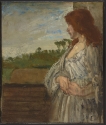Home > Catalogue > Browse > Subject Unknown << >>

Composition
A rather illegible letter from Whistler to Fantin-Latour describes a 'toile de vingt':
'il fait un temps de tous les diables! Je regrette la petite toile de [20?]. C'est une tranchée de chemin de fer - mais il semble impossible de pouvoir la finir, car chaque fois qu'il pleut on est obligé d'attendre trois jours pour que la terre seche avant de pouvoir y travailler!' 1
Translation: 'the weather is devilish! I am sad about the little 20 [size?] canvas. It is a railway cutting - but it seems impossible to finish, because every time it rains one has to wait three days for the ground to dry before being able to work on it!'
In the original letter, 'toile de 20' could also be read as 'toile de Jo', the '20' or 'Jo' being overwritten and practically indecipherable. The reference to the weather suggests he was painting 'en plein air' by a railway, which, by November, even in the south of France, was hardly practical.
It has been suggested that the painting referred to here was A White Note [YMSM 044], which includes a railway in the distance and the figure of Joanna Hiffernan (b. ca 1843-d.1886) in the foreground. However, the canvas of A White Note measures 36.8 x 31.8 cm. (closer to a 'toile de 6', smaller than the 'toile de 20' (a canvas of 73 x 60 cm or 73 x 50 cm). It remains possible that it was the same canvas, but was cut down.
Technique
Nothing is known about the technique, except that it was a 'toile de vingt' and thought sufficiently complete to be framed. The 'toile de vingt' indicated a canvas stretcher measuring either 73 x 60 cm (for landscape paintings) or 73 x 50 cm (for marine paintings).
Conservation History
Unknown.
Frame
On 18 October [1862] Whistler wrote to George Aloysius Lucas (1824-1909) from Guéthary, Basses-Pyrénées, asking him to purchase in Paris two frames, one of which was for a 'toile de vingt', which Whistler wanted to be 'a very pretty frame, highly finished, brilliant and rich - deep also, and rather broad. This is an order and will hang in a drawing room, so that the finish must not be neglected.' 2 On 27 October Whistler wrote again to Lucas, 'I think the people for whom the picture is painted would rather pay 130 fr than 150 fr.' 3 Whistler also told Lucas that he intended sending a painting (it is by no means certain this is the same painting) to Hardy-Alan's colour shop at 1 rue Childebert in Paris, to be framed and then, hopefully, sent to the 'Boulevards Exposition' (Société Nationale des Beaux-Arts). 4 Lucas, having already ordered the frames on 21 October 1862 from Dutocq's, accompanied Whistler to see them in Paris on 2 December. 5 In December 1862 Lucas received from Whistler a cheque for 280 francs to pay the frame maker, with a request to dispatch the two frames by 'petite vitesse' to Whistler's address in London. 6
Last updated: 26th November 2019 by Margaret





